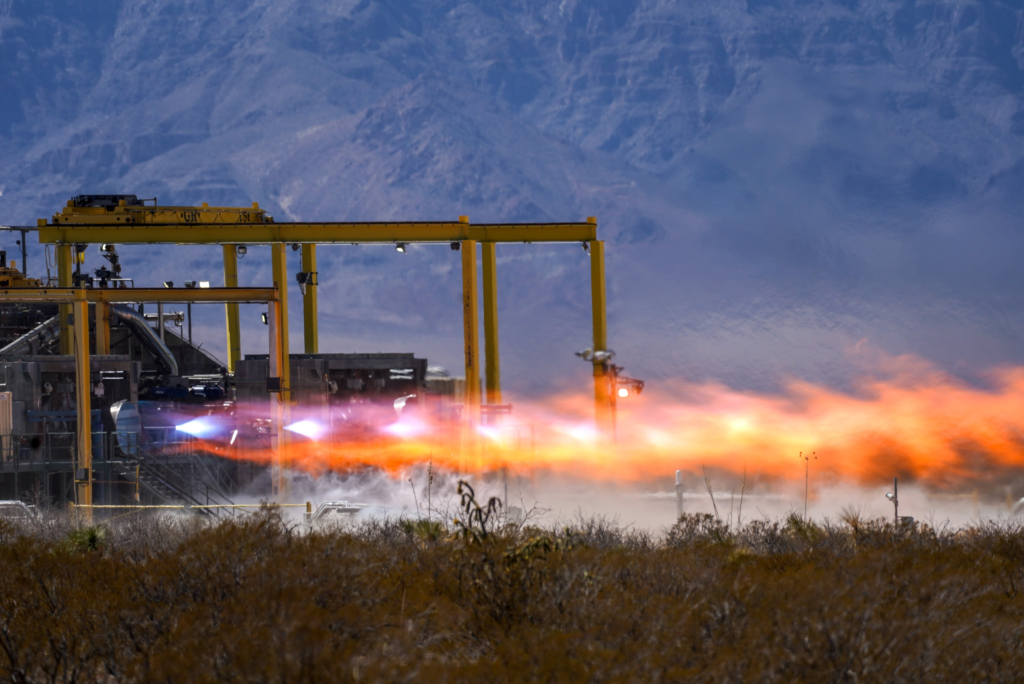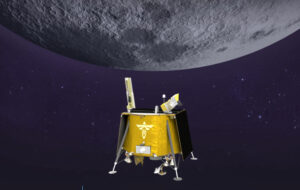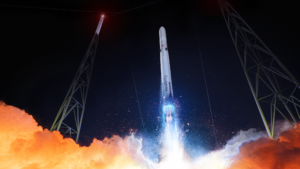
ULA Has Officially Received Both BE-4 Engines For Vulcan
Almost a decade ago in 2014, Blue Origin announced it had made a deal with United Launch Alliance and would be providing BE-4 engines for the company’s next generation Vulcan rocket. Since then, there have been quite a few ups and downs regarding progress and delays as various issues arose with the development and testing of these engines.
Thankfully, after all this time, ULA has officially received both BE-4 flight engines for Vulcan. As of right now, the company is working to install the final engine on the Vulcan test article that is set to lift off very soon. Once installed, the company will ship the finished rocket to its launch site sometime this month. It will then undergo a final series of tests to verify its readiness for flight.
Over time ULA has managed to become one of the most consistent and reliable launch providers within the industry. A pattern they are hoping to withhold in the coming years as the Vulcan Centaur and its BE-4 engines are put to the test for the first time. Here I will go more in-depth into the BE-4 delivery, final installation, what to expect in the future regarding launch preparation, and more.
Two BE-4s Delivered

In the last few weeks, we have been receiving a bunch of new updates as Blue Origin finished some of the final steps and ULA began receiving its flight engines. Just two days ago however, the biggest news yet came when both companies officially announced that the final engine has been delivered and Vulcan now has practically everything it needs to begin final testing prior to launch. Specifically, on October 31st ULA CEO Tory Bruno tweeted saying, “BE4 is in the house!! FE2 is on. FE1 will join it momentarily.” This included an image of BE4 FE2 installed on the launch vehicle with FE1 being prepared to join it after arriving. In addition, Blue Origin commented on this important milestone with a tweet mentioning, “The first shipset. The first of many. #BE4 flight engines are now being integrated into the @ulalaunch#VulcanRocket” In reality, this is quite a significant moment as this deal originated almost a decade ago and the company has finally received the first official flight engines.
Blue Origin also included in this tweet a few images of past testing of the two flight engines. Over the last few months, we watched Flight Engine 1 and 2 go through early development, initial testing, all the way up to full duration fires, and the eventual delivery. To better put the timeline in perspective, back in early August Tory Bruno tweeted highlighting, “The BE4 Flight engine #1 is in Texas for its acceptance firing. But I forgot to share this picture taken right before it left Kent. Standard Reference included for scale…” Here you could see the BE-4 in the factory prior to leaving. This is the same engine that was just delivered after completing all of its testing two days ago. In terms of the timeline for engine installation, after the first flight engine was delivered to ULA, it only took a few days before it was installed on Vulcan. We can likely expect the same as both engines will be installed and ready in just a couple of days from now.
In addition, Bob Smith, the CEO of Blue Origin commented, “We’re excited to see ULA’s Vulcan fly. The BE-4 is a great engine, and we’re proud of Team Blue for achieving this milestone as part of ULA’s team. It’s been a wonderful partnership, and this shipset is the first of many more to come.” Tory Bruno also commented, “We are very pleased to receive the first two engines for Vulcan’s inaugural flight. Development of this new engine is complete, and the performance of the engine is outstanding. It has been a great team effort working together with our partners at Blue Origin and we can’t wait to see Vulcan fly.”
Vulcan’s First Launch

Now that we know more about the recent engine delivery and its importance, we can take a closer look at the engine itself, and when we should expect to see it in action apart of Vulcan’s first flight. Currently, United Launch Alliance is still targeting the first quarter of 2023 for Vulcan’s maiden flight. This suggests that in only a few months, we could see the two provided BE-4s in a real launch. Based on reports from ULA and the recent final engine delivery, within the next couple of weeks, the company will transport the rocket to the launch site in the Cape. Once at the launch site, Vulcan will undergo a final series of tests to verify its readiness for flight consisting of multiple tanking tests and a wet dress rehearsal, resulting in flight readiness firing next month in December, which will be the final step prior to launch. If everything goes according to plan and the BE-4 engines among other aspects provide promising results after testing, Vulcan will be ready to lift off.
As we know by now, Vulcan relies on two BE-4 engines for the majority of thrust on its first stage. Each BE-4 engine provides 550,000 pounds of thrust and has completed an extensive development program. This engine and deal between the two companies is intended to end reliance on Russian engines and power a new generation of U.S. launch vehicles. Blue Origin highlighted that dozens of these engines are now in production to support a large and growing demand for civil, commercial, and defense launches. This production will be necessary as both Vulcan and New Glenn require multiple BE-4 engines.
When it comes to engines, Blue Origin believes operationally reusable rockets demand high performance engines capable of deep throttling for soft landings. Built for multiple uses, their family of engines is attempting to power the next generation of rockets for commercial, civil, national security, and human spaceflight. These Engines are designed, developed, and manufactured at its headquarters in Kent, Washington. By now they are preparing for serial production of their most powerful engine, the BE-4, in Huntsville, Alabama. They point out that BE-4 was designed from the beginning to be a medium-performing version of a high-performance architecture. A conscious design choice made to lower development risk while attempting to meet performance, schedule, and reusability requirements. Currently there is an unofficial race between a few different companies and launch vehicles surrounding the first flight of a methane filled or liquid natural gas powered rocket. Starship, Terran 1, New Glenn, and Vulcan are the four vehicles each with its own progress and timeline. Currently, Vulcan and the BE-4 could very well be the first but we will have to wait and see.
BE-4 is one of the most powerful liquefied natural gas (LNG) fueled rocket engines ever developed. Using an oxygen-rich staged combustion cycle, BE-4 is capable of producing 2,400 kilonewtons or (550,000 lbf) thrust with deep throttle capability. In addition to Vulcan’s two BE-4s on the first stage, there are also between two and six configurable solid rocket boosters. Specifically, Vulcan integrates up to six Northrop Grumman Graphite Epoxy Motor (GEM) 63XL Solid Rocket Boosters (SRBs). They are constructed out of a graphite-epoxy composite with the throttle profile designed into the propellant grain. Leveraging the proven processes, technology and expertise of Atlas and Delta, the Vulcan Centaur rocket introduces new technologies and innovative features to try and create the highest value launch service with optimal performance to meet the full range of mission requirements. Vulcan Centaur consists of a single booster stage, the high-energy Centaur upper stage powered by two RL10 engines, and a 5.4-meter-diameter payload fairing. By making launch more affordable, Vulcan Centaur opens up new opportunities for space capabilities, offering unprecedented flexibility in a single system. From low-Earth orbit to Pluto, the single-core Vulcan Centaur does it all.
At the top of the rocket, the payload fairing (PLF) provides a controlled, safe environment for spacecraft during ascent. All ULA PLFs are configured for off-pad payload encapsulation to enhance payload safety and security and minimize on-pad time. The spacecraft is encapsulated in a 5.4-m- (17.7-ft-) diameter payload fairing (PLF), a sandwich composite structure made with a vented aluminum-honeycomb core and graphite-epoxy face sheets. The bisector (two-piece shell) PLF encapsulates the spacecraft. The payload attach fitting (PAF) is a similar sandwich composite structure creating the mating interface from the spacecraft to the second stage and payload fairing. The PLF separates using a debris-free horizontal and vertical separation system with spring packs and frangible joint assembly. The payload fairing is available in the 15.5-m (51-ft) standard and 21.3-m (70-ft) long configurations. Lastly, for a while now, ULA has been heavily investing in modifying its factory in Decatur, Alabama, and modernizing its infrastructure at the launch facilities in Cape Canaveral, Florida, to support Vulcan rockets. Space Launch Complex-41 (SLC-41) will be the first dual-use pad launching both Atlas V and Vulcan rocket families.
Conclusion
ULA and Blue Origin are both quite happy after the first official delivery of both BE-4 engines. Over the past couple of months, we have watched these two flight engines go through testing and now are practically ready for flight. We will have to wait and see how it progresses and the impact it has on the space industry.



